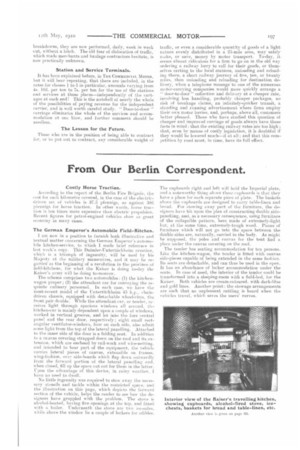From Our Berlin Correspondent.
Page 9

If you've noticed an error in this article please click here to report it so we can fix it.
Costly Horse Traction.
According to the report of the Berlin Eire Brigade, the cost for each kilometre covered, in the case of the electricdriven set of vehicles is 37.5 pfennigs, as against 386 pfennigs for horse traction. In other words, horse traction is ten times more expensive than electric propulsion. lieeent figures for petrol-engined vehicles show as great economy in many cases.
The German Emperor's Automobile Field-Kitchen. I am now in a position to furnish both illustrative and textual matter concerning the German Emperor's automo bile kitchen-service, to which made brief reference in lest week's copy. This Daimler-Untertiirkheim creation, which is a. triumph of ingenuity, will be used by his Majesty at the military manceuvres, and it may be regiusled as the beginning of a revolution in the province of field-kitchens, for what the Kaiser is doing to-day the Kaiser's army will be doing to-morrow. The 8ebente comprises two automobiles : (1) the kitchenwagon proper ; (2) the attendant car for conveying the requisite culinary personnel. In each case, we have the most-recent model of the Untertiirkheim 45 h.p., chaindriven chassis, equipped with detachable wheel-rims, the front pair double. While the attendant car, or tender, receives light through spacious windows all around, tIli, kitchen-car is mainly dependent upon a coeple of windows, worked in vertical grooves, and let into the fore central panel and the rear door, respectively; eight small rectangular ventilator-windows, four on each side, also admit some light from the top of the lateral panelling. Attached to the inner side of -the door is a. folding seat. In addition to a canvas covering strapped down on the roof and its extension, which are enclosed by rail-work and wire-netting, and intended to bear part of the equipment, the vehicle carries lateral pieces of canvas, extensible on Ira lines, wing-fashion, over side-hoards which flap down outwardly from the forward portion of the lateral panelling and, when closed, fill up the space cut out for them in the latter. I7pon the advantage of this device, in rainy weather. I have no need to dwell.
No little ingenuity was required to stow away the necessary utensils and tackle within the restricted space. and the illustration on this page, which depicts the forward section of the vehicle, helps the reader to see how the designers have grappled with the problem. The stove is alcohol-heated, having five openings at the top, and fitted with a boiler. Underneath the stove are tan ice-safes, while above the window lie a couple of lockers for edibles. The cupboards right and left will hold the Imperial plate; and a noteworthy thing abant these cupboards is that, they have a place for each separate piece of plate. The baskets. above the cupboards are designed to carry table-linen and bread. For stowing away part of the furniture, the designers have hit upon the plan of constructing double sidepanelling, and, as a necessary consequence, using furniture of the collapsible pattern, here made of extremely-light but. at the same time, extremely-tough wood. Pieces of furniture which will not go into the space between the double sides are, naturally, carried in the lxxly. As might be supposed, the poles and canvas for the tent find a. place under the canvas covering on the roof.
The tender has seating accommodation for ten persons_ Like the kitchen-wagon, the tender is fitted with canvas side-pieces capable of being extended in the same fashion. Its seats are detachable, and can thus be used in the open_ It has an abundance of locker accommodation under the seats. In case of need, the interior of the tender could be trensformed into a sleeping-room with a field-bed, for the Kaiser. Both vehicleare cream-coloured, with dark-blue and gold lines. Another point : the stowage arrangements are such that no unpleasant rattling is heard when the vehicles travel, which saves the users' nerves.
























